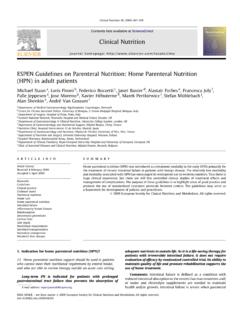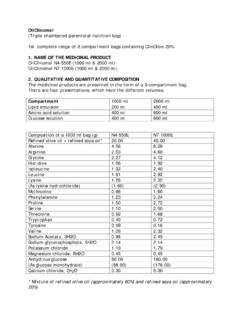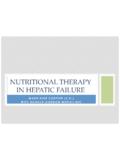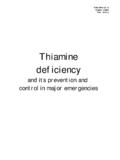Transcription of Evaluation of Liver Disease in the Pediatric Patient
1 Evaluation of Liver Disease in the Pediatric PatientIan D. D Agata, MD* and William F. Balistreri, MD OBJECTIVESA fter completing this article, readers should be able to:1. List the age-specific causes of Liver Disease in neonates, infants, olderchildren, and Explain why fractionation of serum bilirubin is necessary in infantswho remain jaundiced after 2 weeks of Characterize the syndrome of neonatal hepatitis and explain how itdiffers from viral Characterize biliary atresia and identify findings from the history,physical examination, and laboratory Evaluation that may suggest Describe a quick, cost-effective diagnostic approach to a neonate whopresents with clinicians often do not rec-ognize the presence of underlyingliver Disease , precise documentationof the disorder can be delayed,which can lead to a subsequentdelay in the initiation of effectivetherapies.
2 Liver transplantation is areality for Pediatric patients whohave severe or end-stage Liver dis-ease, and other therapies also arenow available for treating manyliver estimated incidence of neo-natal Liver Disease is as high as 1 in2,500 live births. Early recognitionis particularly important in neonatesand infants because a delay in diag-nosis may have a negative effect onthe prognosis. For example, it iswell recognized that when biliaryatresia is diagnosed after 2 monthsof age, the success rate of surgicalrepair (Kasai hepatoportoenteros-tomy) declines sharply. Furthermore,because Liver dysfunction is progres-sive, early recognition allows forbetter nutritional support of thepatient and a potentially slowerdecline in Liver function. The resultcan be improved growth and fewercomplications. This is of consider-able importance because orthotopicliver transplantation generally ismore successful in infants whoweigh more than 10 kg at the timeof , the timely recogni-tion of severe Liver Disease in thepediatric Patient remains a majorproblem.
3 One contributing factor isthat injury to the Pediatric livermanifests in a finite number ofways; hence, different disordersoften have virtually identical initialpresentations. For example, neonateswho have Liver injury almost alwayspresent with jaundice. Unfortunately,the difference between physiologichyperbilirubinemia and hyperbiliru-binemia indicative of severe liverdisease often is unappreciated. Datafrom the United Kingdom have doc-umented several factors contributingto late referral of infants who haveliver Disease (Table 1). This also isa problem in the United States,where late referrals for biliary atre-sia and other serious causes of liverdysfunction still causes of Liver Disease in pedi-atric patients vary with age (Table2). Some are associated with certainage groups, such as biliary atresiaand idiopathic neonatal hepatitis,which are observed only at birth orshortly thereafter.
4 Conversely, alco-hol or acetaminophen intoxicationand Wilson Disease are typical ofolder children, especially adoles-cents. Furthermore, although neo-natal hepatitis may be caused byviruses, it is not the same entity asthe viral hepatitis observed in olderchildren and adolescents. Under-standing that specific diseases aremore common, if not exclusive, tocertain age groups is of great help infocusing the Evaluation and definingthe cause of underlying Liver dis-ease. It is important to rememberthat despite the long list of disordersassociated with Liver Disease in theneonate, most are encounteredrarely. Further, although lists of thevarious etiologies leading to pediat-ric Liver Disease are extremelylengthy, about 10 diseases constituteapproximately 95% of all cases ofcholestasis seen, and of these, bili-ary atresia and neonatal hepatitis areresponsible for more than 60%.
5 In general, the clinician initiallysuspects Liver Disease in the neonatewho presents with classic signs,such as persistent jaundice, hepato-megaly, coagulopathy, or failure tothrive. At other times, incidentalfindings of abnormalities on serumchemistries may suggest the diagno-sis. Jaundice, confusion, and comaoccur in older children and adoles-cents who have acute hepatitis orfollowing toxin exposure. Pruritus,seen in older children who havecholestasis, may manifest as irrita-bility in infants. No matter what thepresentation, a stepwise analysis ofhistorical data, clinical findings, andlaboratory values allows initiation of* Pediatric Gastroenterology & LiverDiseases, Valley Children s Hospital,Madera, CA. Chief, Division of Gastroenterology &Nutrition, Children s Hospital MedicalCenter, Cincinnati, :autoimmune hepatitisALT:alanine aminotransferaseAP:alkaline phosphataseAST:aspartate aminotransferaseCT:computed tomographyGGT:gamma glutamyltranspeptidaseHAV:hepatitis A virusHBV:hepatitis B virusHCV:hepatitis C virusHDV:hepatitis D virusHEV:hepatitis E virusLFT: Liver function testMRI:magnetic resonance imagingPT:prothrombin timePTT:partial thromboplastin timeARTICLE376 Pediatrics in ReviewVol.
6 20 No. 11 November 1999the most appropriate and cost-effective strategy to diagnose andtreat the underlying and Signs of LiverDiseaseNEONATEA lthough an infant may have beenjaundiced at birth (physiologichyperbilirubinemia) or may bebreastfeeding, it is importantnottoattribute jaundice in an infant olderthan 14 days to one of these in any infant after 2 weeksof age should raise the suspicion ofliver Disease and prompt appropriateevaluation. A careful history mayprovide clues about the existenceand type of Liver Disease . For exam-ple, the onset of Liver Disease associ-ated with dietary changes may sug-gest an inborn error of carbohydratemetabolism, such as an inability tometabolize galactose or positive family history for a sus-pected genetic disorder (such asAlagille syndrome) should focus theinitial Evaluation in that recurrent clinical phenotypewithin a family suggests an inheriteddisorder such as tyrosinemia orByler syndrome (progressive famil-ial intrahepatic cholestasis).
7 Idiopathic neonatal hepatitisappears to be more common amongmales, especially preterm or low-birthweight infants. In contrast, bili-ary atresia occurs more commonlyamong females of normal weight,and the rate of intrafamilial recur-rence approaches zero. Also, anassociated polysplenia syndromefavors a diagnosis of biliary who have biliary atresiaexperience an earlier onset of jaun-dice and of acholic stools comparedwith those who have fever or other signs ofinfection suggest sepsis as theunderlying cause of jaundice in theneonate. Gram-negative bacteria(eg,Escherichia coli) causing uri-nary tract infections are cholestatic Disease , jaundicealmost invariably is present in thefirst month of life. Unfortunately,jaundice is not recognized in infantsuntil the first health supervisionvisit, which leaves little time fordiagnosis and surgical correction ofbiliary atresia, which ideally shouldoccur within the first 2 months oflife.
8 The Figure details a rapid step-wise approach to rule out biliaryatresia in an infant presenting withcholestasis before 2 months of stools also are highlycharacteristic of cholestasis ininfancy. In the presence of extra- orintrahepatic obstruction, little or nobilirubin is excreted into the intes-tine, resulting in no color to the neo-formed fecal material. Althoughsome pigment may be present in thestools of neonates who have biliaryobstruction because of desquamationof cells containing pigment into thestool, these stools usually are muchlighter than those found in healthyinfants. Furthermore, breaking thestool into pieces will show that thepigment is only superficial, with theinternal part exhibiting a clay color-ing at CHILDIn older children, a history docu-menting anorexia, fever, vomiting,abdominal pain, darkening of theurine, especially following ingestionof crustaceans or shellfish of dubi-ous provenance, should lead to thesuspicion of hepatitis A virus(HAV) infection.
9 HAV infectionalso is the likely etiology of liverdisease in any child who has a his-tory of a flu-like illness and sud-denly develops jaundice with ele-vated aminotransferase values in theabsence of other known hepatotoxicexposures. Hepatitis A is often anic-teric in young children (,5y)andfrequently is of Liver Disease in patientswho have received tattoos, who useintravenous drugs, or in whom anunderlying condition led toincreased exposure to parenterallyadministered blood products (hemo-dialysis, hemophilia, surgery) priorto widespread screening (1992) cansuggest hepatitis C infection. Teen-agers who become jaundiced alwaysshould be questioned privately aboutintravenous drug abuse and exposureto crack cocaine, the intranasal useof which recently has been shown tobe associated with hepatitis C (shar-ing of glass paraphernalia) and pos-sibly hepatitis B infection.
10 If thecourse of a documented hepatitis Binfection is particularly severe, coin-fection or superinfection with hepa-titis D (delta) should be homosexuals are at anincreased risk to develop always is important to elicit ahistory of exposure to potentiallyhepatotoxic medications, includingisoniazid, nitrofurantoin, sulfon-amides, and nonsteroidal anti-inflammatory agents, such as acet-aminophen and ibuprofen. If anoverdose or an intoxication is thecause of Liver dysfunction, childrencan present with altered mental sta-tus and even coma. Confusion andcoma suggest Liver failure or meta-bolic Disease leading to hyperam-monemia, hypoglycemia, or a com-bination of both. Female teenagerswho develop jaundice and have his-tories of acne, intermittent arthritis,and fatigue may have autoimmunehepatitis, although this entity canoccur less commonly in boys and inyounger who have immunodefi-ciencies and become jaundiced mayhave an infection with cytomegalo-virus, Epstein-Barr virus, or retrovi-rus.
















